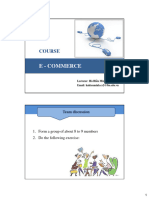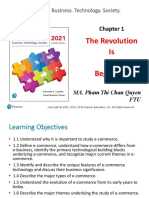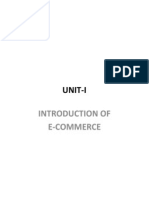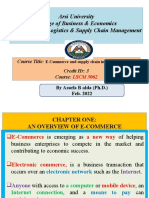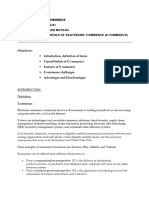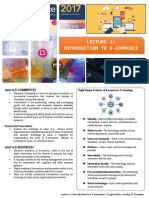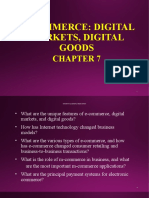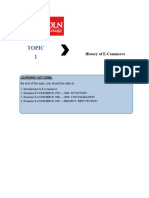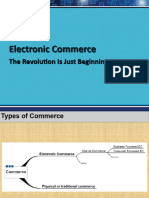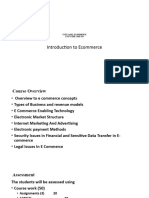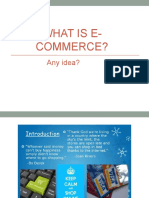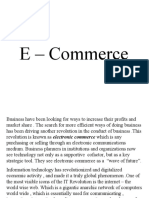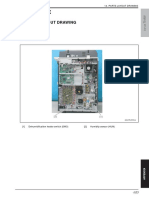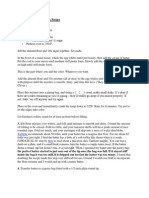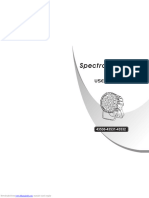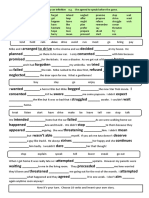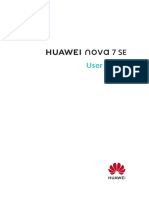COURSE
E - COMMERCE
Lecturer: Hà Hiền Minh
Email: hahienminh.cs2@ftu.edu.vn
CONTENT
- Chapter 1: Introduction to e-commerce
- Chapter 2: The e-commerce business models
- Chapter 3: Building an e-commerce website
- Chapter 4: E-marketing
- Chapter 5: Digital signature
1
� GRADING CRITERIA
- Attendance: 10%
- Mid-term score: 30%, includes
+ 10%: mid-term test
+ 20%: Group project
- Final test: 60%
GROUP PROJECT
• Idea: (50%)
+ Product? (10%)
+ Customer? (10%)
+ E-commerce business models? (30%)
• Technology: (50%)
+ Website: content (10%); context (10%)
+ Extensions (20%): at least 4
+ E-marketing tools (10%)
2
� Notice
- Attending on the presentation day is required. Anyone who
absent will get the grade deducted 30%. If you have an
appropriate reason, the grade will be deducted 10%;
- Before the presentation, each group should check the
possibility of connecting your laptop to the projector;
- Preparing presentation before class to avoid wasting time to
correct mistakes.
TEXTBOOK
Kenneth C. Laudon & Carol
Guercio Traver, 2021-2022, E-
commerce: business. technology.
society
3
� REFERENCES
1. E-commerce textbook (published by Foreign Trade
University)
2. Vietnam E-commerce Report (from 2005 to 2022)
3. www.vecom.vn (VN e-commerce Association)
4. www.idea.gov.vn (VN e-commerce and Digital
economy Agency)
5. Newspaper, books.....
4
� SCHEDULE
SESSION CONTENT
Day 1 Overview of this course
Day 2 - 4 Chapter 1: Introduction to E-commerce
Day 5 - 7 Chapter 2: The E-commerce Business Models
Chapter 3: Building an E-commerce website
Day 8
Practice at class
Day 9 - 10 Chapter 4: E-marketing
Day 11 Chapter 5: Digital signature
Day 12 Mid-term test
Day 13 - 15 Group report + Guest speaker
5
� Group discussion
Discuss the following questions:
WHAT ARE
PROMINENT
EVENTS/
APPLICATIONS OF
E-COMMERCE IN
RECENT YEARS?
6
�1. User-generated content, published online as social network posts, continues to grow and provides a method of self-publishing that
tweets, blogs, and pins, as well as video and photo-sharing, engages millions.
as Facebook comes under fire for allowing third parties such as
2. Social networks encourage self-revelation, threatening privacy, Cambridge Analytica, device makers, and app developers to mine its
database of user information without user consent.
storing consumer content and software on “cloud” (Internet-based)
3. Cloud computing completes the transformation of the mobile
servers and making it available to any consumer-connected device, from
platform by
the desktop to a smartphone.
4. Concerns increase about increasing market dominance of Facebook, leading to calls for government regulation in both the European Union
Amazon, and Google, and the United States.
there is substantial agreement among online distributors and copyright
5. Conflicts over copyright management and control continue, but
owners that they need one another.
comprised of billions of Internet-connected devices, continues to grow
6. The Internet of Things (IoT),
exponentially.
7. Concerns over commercial and governmental privacy invasion increase.
continues to decline as major companies are hacked and lose control
8. Online security
over customer information.
9. A mobile computing and communications platform based on
a reality, creating an alternative platform for online transactions,
smartphones, tablet computers, wearable devices, and mobile apps
marketing, advertising, and media viewing.
becomes
10. On-demand service e-commerce produces a flood of temporary, poorly paid jobs without benefits.
11. Although global economic activity declined in 2020 due to the B2B e-commerce revenues remained stable and are expected to
pandemic, continue to increase.
12. Small businesses and entrepreneurs continue to flood into the e- often riding on the infrastructures created by industry giants such as
commerce marketplace, Apple, Facebook, Amazon, Google, and eBay.
Amazon Echo and Google Home become increasingly popular,
13. Smart speakers such as
providing an additional platform for e-commerce.
sophisticated software called business analytics (or web analytics) that
14. In order to make sense out of big data, firms turn to can identify purchase patterns as well as consumer interests and
intentions in milliseconds.
15. Spam remains a significant problem.
CHAPTER 1
INTRODUCTION TO E - COMMERCE
7
�Chapter 1: Introduction to E-commerce
1 History of E-commerce
2 Definition of E-commerce
3 The overview of Vietnam E-commerce
4 Pros and Cons of E-commerce
1. History of E-commerce
2007 – Present:
REINVENTION
2001 - 2006:
CONSOLIDATION
1995 – 2000:
INVENTION
8
� 1. History of E-commerce
1995 – 2000: INVENTION
• A period of explosive growth and extraordinary I...
• Key e... were developed and explored
• Thousands of d… companies were formed
• The first widespread use of the web to a… products
• A period which was characterized by experimentation,
capitalization and hypercompetition;
1. History of E-commerce
2001 - 2006: CONSOLIDATION
• A more approach rather than
technology-driven
• became more important than creating
new things
• Financing as capital markets start-
up firms
9
� 1. History of E-commerce
2007 - Present: REINVENTION
• A period of reinvention involving the extension
of Internet technologies, the discovery of new
business models based on consumer-generated
content, social networking and virtual online
lives.
EVOLUTION OF E-COMMERCE
1995 - 2000 2001 - 2006 2007 - Present
Mobile technology enables
Technology - driven Business - driven social, local, and
mobile commerce
Revenue growth Earnings and profits Audience and social network
emphasis emphasis connection emphasis
Smaller investments; early
Venture capital financing Traditional financing small firm buyouts by large
online players
Stronger regulation and Extensive government
Ungoverned
governance surveillance
Entrepreneurial social and
Entrepreneurial Large traditional firms
local firms
10
� EVOLUTION OF E-COMMERCE
1995 - 2000 2001 - 2006 2007 - Present
Proliferation of small online
Strengthening intermediaries renting
Disintermediation
intermediaries business processes of larger
firms
Continuation of online
Imperfect markets, brands market imperfections;
Perfect markets
and network effects commodity competition in
select markets
Return of pure online
Mixed “bricks and clicks” strategies in new markets;
Pure online strategies
strategies extension of bricks and clicks
in traditional retail markets
EVOLUTION OF E-COMMERCE
1995 - 2000 2001 - 2006 2007- Present
Strategic follower First-mover advantages return
First-mover advantages strength; complimentary in new markets as traditional
assets web players catch up
Low complexity retail High complexity retail
Retail, services and content
products products
11
�1. History of E-commerce
12
�8 UNIQUE FEATURES OF E-COMMERCE TECHNOLOGY
Internet/Web is available everywhere: at work, at home
and elsewhere via mobile devices, anytime
The technology reaches across national boundaries,
around the Earth
There is one set of technology standards, namely
Internet standards
Video, audio and text messages are possible
The technology works through interaction with the user
The technology reduces information costs and raises
quality
The technology allows personalized messages to be
delivered to individuals as well as groups
User content generation and social networking
2. Definitions of E-commerce
The narrow sense
The broad sense (Definition of UNCTAD)
13
� 2.1. Definition of EC in narrow sense
E-commerce is the buying or selling
of goods and services over electronic
means and telecommunication
networks, especially computer and
the Internet .
ELECTRONIC MEANS
An electronic means is a means that operates based on
electric, electronic, digital, magnetic, wireless, optical,
electro-magnetic technologies or similar technologies.
Source: Clause 10, Article 4, Law on e-transactions,
No. 51/2005/QH11
14
� TELECOMUNICATION NETWORKS
▪ Telephone landline network;
▪ Cable television network;
▪ Mobile network (cellular network: 3G, 4G, 5G);
▪ Internet (wifi??? Wireless network)
▪ Intranet/ Extranet;
COMMERCIAL ACTIVITIES
Commercial activities mean activities for the purpose
of generating profits, including: sale and purchase of
goods, provision of services, investment, commercial
promotion and other activities for the profit purpose.
Source: Clause 1, Article 3, Commercial law,
No. 36/2005/QH11
15
� 2.2. Definition of EC from UNCTAD
Horizontal definition of E-commerce -
Enterprises’ concerns: MSDP
Vertical definition of E-commerce:
Governments’ concerns: IMBSA
theo góc độ nhà quản lý: chính phủ/ các doanh nghiệp
IMBSA: phải viết theo đúng thứ tự. Đây là các cấp độ để phát triển
hoạt động thương mại điện tử
Infrastructure (internet và world wide web) - message (thông điệp, dữ liệu) - basic law - specific law - application
3 luật: luật giao dịch điện tử, luật cntt, luật viễn thông
tại sao thông điệp dữ liệu
MSDP
16
� E-Marketing
E-marketing activities
• Market research
• Website marketing
• E-mail marketing
• Search engine marketing
• Mobile marketing
• Social networks
•…
E-sales
• Place an order online
• Shopping cart
• Customer database
• Traffic management
• Automated sales process
17
� E-distribution
Downloads (digital goods): Digital goods are commodities or
products that exist in a digital form, something that can be sold
and consumed online.
Effective improvement of distribution system (traditional
goods)
• E-logistics
• E-customs
• E-C/O
• E-warehouse
• E-supply chain management
• E-delivery management
E-payment
E-commerce payment systems:
• Credit card
• Digital wallet
• Digital cash
• Online stored value payment
systems
• ....
18
� IMBSA
Infrastructure
Internet: an interconnected network
• 1961 – 1974: innovation phase
• 1975 – 1994: institutionalization phase
• 1995 – present: commercialization phase
19
� Infrastructure
Infrastructure
Internet: an interconnected network
• 1961 – 1974: innovation phase
• 1975 – 1994: institutionalization phase
• 1995 – present: commercialization phase
World wide web / Web
• Web 1.0
• Web 2.0
• Web 3.0, 4.0
20
� Web 3.0
It is the “executable” phrase of Word Wide Web with
dynamic applications, interactive services, and
“machine-to-machine” interaction. Web 3.0 is a
semantic web which refers to the future. In Web 3.0,
computers can interpret information like humans and
intelligently generate and distribute useful content
tailored to the needs of users.
Message
A data message means information created,
transmitted, received and stored by electronic
means.
Source: Clause 12, Article 4, Law on e-transactions,
No. 51/2005/QH11
21
� Message
Legal validity of data message
Information in data messages cannot have its
legal validity disclaimed for the sole reason that
it is expressed in the form of data messages.
Source: Article 11, Law on e-transactions,
No. 51/2005/QH11
Basic & Specific Rules
Basic
Rules
(Source: Vietnam E-commerce Report)
22
� Basic & Specific Rules
Specific
Rules
(Source: Vietnam E-commerce Report)
Definition of EC by Laudon
E-commerce is the use of the
Internet, the Web, and apps to
transact business. More formally,
digitally enabled commercial
transactions between and among
organizations and individuals.
Source: Laudon, 2015
23
� NOTE 1
1. “Brick and mortar” business model: physical stores
2. Virtual (pure-play) business model (click and
browse): online stores
3. “Click and mortar” (brick and click) business model:
physical + online stores
NOTE 2
24
� NOTE 3
E-commerce E-business
Primarily involves the
Primarily involves
application of digital
transactions that cross
technologies to business
firm boundaries
processes within the
firm
NOTE 3
25
� 3. The overview of VN E-commerce
- ECVN portal hosted by the Ministry
of Industry and Trade was officially
put into operation from 8/2005
- Law on E-transactions was
approved in 11/2005 and effected
from 03/2006
- 6/2006: published Law on 2011
information technology
- 25/6/2007: Vietnam E-commerce 2009
Association was established
2007
2005
Overview of VN E-commerce
2011
2009
2007 - 6/2008: establish Root Certification Authority
(belong to Authority of Information and
Communications application)
- Implement TrustVn program (13/6/2008)
2005 - E-payment gateway “Smartlink – MasterCard”
was launched on 16/3/2009
- Law on telecommunication was approved in
11/2009
26
� Overview of VN
- Enterprises E-commerce
strongly applied specialized software
(such as: CRM, SCM, ERP...) and started using
online public services provided by state agencies
(such as: electronic tax filling, electronic customs,
electronic import/export procedures, electronic
C/O...)
2011
2009
2007
2005
Overview of VN E-commerce
2011
2009
- Marked the end of 5 years’
implementation of the Master
2007
Plan on E-commerce
Development for the 2006 –
2010 period.
2005
27
� Overview of VN E-commerce
- Implementing the Master
Plan on E-commerce
Development for the 2011-
2015 period and 2016-2020
period
2011
2009
2007
2005
3. The overview of VN E-commerce
28
� 4. Pros and Cons of E-commerce
4. Pros and Cons of E-commerce - Pros
Reduce cost,
Increase revenue
Build and develop
To the customer relationship
Business
Improve
competitiveness
29
� 4. Pros and Cons of E-commerce - Pros
Lower price
To the
Customer
More convenience
4. Pros and Cons of E-commerce - Cons
Lack of security
To the
Customer
Breakdown of
human relationships
30
�4. Pros and Cons of E-commerce
31

